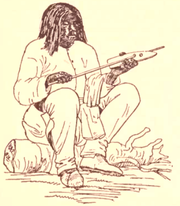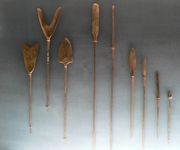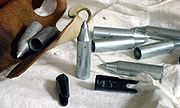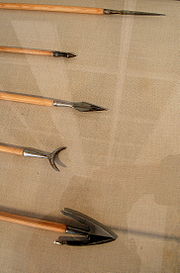
Arrow
Encyclopedia


Projectile
A projectile is any object projected into space by the exertion of a force. Although a thrown baseball is technically a projectile too, the term more commonly refers to a weapon....
that is shot with a bow
Bow (weapon)
The bow and arrow is a projectile weapon system that predates recorded history and is common to most cultures.-Description:A bow is a flexible arc that shoots aerodynamic projectiles by means of elastic energy. Essentially, the bow is a form of spring powered by a string or cord...
. It predates recorded history and is common to most cultures.
An arrow usually consists of a shaft with an arrowhead attached to the front end, with fletchings and a nock at the other.
History
In 2010, during an excavation at the Sibudu CaveSibudu Cave
Sibudu Cave is a cave in a sandstone cliff in northern KwaZulu-Natal, South Africa. It is an important Middle Stone Age site occupied, with some gaps, from 77,000 years ago to 38,000 years ago...
in South Africa
South Africa
The Republic of South Africa is a country in southern Africa. Located at the southern tip of Africa, it is divided into nine provinces, with of coastline on the Atlantic and Indian oceans...
, led by Professor Lyn Wadley from the University of the Witwatersrand
University of the Witwatersrand
The University of the Witwatersrand, Johannesburg is a South African university situated in the northern areas of central Johannesburg. It is more commonly known as Wits University...
, researchers discovered the earliest direct evidence of human
Human
Humans are the only living species in the Homo genus...
-made arrowheads: 64,000-year-old stone points which may have been shot from a bow. These had remnants of blood
Blood
Blood is a specialized bodily fluid in animals that delivers necessary substances such as nutrients and oxygen to the cells and transports metabolic waste products away from those same cells....
and bone
Bone
Bones are rigid organs that constitute part of the endoskeleton of vertebrates. They support, and protect the various organs of the body, produce red and white blood cells and store minerals. Bone tissue is a type of dense connective tissue...
, confirming their use in hunting.
Size

Mary Rose
The Mary Rose was a carrack-type warship of the English Tudor navy of King Henry VIII. After serving for 33 years in several wars against France, Scotland, and Brittany and after being substantially rebuilt in 1536, she saw her last action on 1545. While leading the attack on the galleys of a...
were 76 centimetres (29.9 in). Very short arrows have been used, shot through a guide attached either to the bow (an "overdraw") or to the archer's wrist (the Turkish "siper"). These may fly farther than heavier arrows, and an enemy without suitable equipment may find himself unable to return them.

Shaft
The shaft is the primary structural element of the arrow, to which the other components are attached. Traditional arrow shafts are made from lightweight woodWood
Wood is a hard, fibrous tissue found in many trees. It has been used for hundreds of thousands of years for both fuel and as a construction material. It is an organic material, a natural composite of cellulose fibers embedded in a matrix of lignin which resists compression...
, bamboo
Bamboo
Bamboo is a group of perennial evergreens in the true grass family Poaceae, subfamily Bambusoideae, tribe Bambuseae. Giant bamboos are the largest members of the grass family....
or reeds
Phragmites
Phragmites, the Common reed, is a large perennial grass found in wetlands throughout temperate and tropical regions of the world. Phragmites australis is sometimes regarded as the sole species of the genus Phragmites, though some botanists divide Phragmites australis into three or four species...
, while modern shafts may be made from aluminium
Aluminium
Aluminium or aluminum is a silvery white member of the boron group of chemical elements. It has the symbol Al, and its atomic number is 13. It is not soluble in water under normal circumstances....
, carbon fibre reinforced plastic, or composite materials. Composite shafts are typically made from an aluminium
Aluminium
Aluminium or aluminum is a silvery white member of the boron group of chemical elements. It has the symbol Al, and its atomic number is 13. It is not soluble in water under normal circumstances....
core wrapped with a carbon fibre outer.
The stiffness
Stiffness
Stiffness is the resistance of an elastic body to deformation by an applied force along a given degree of freedom when a set of loading points and boundary conditions are prescribed on the elastic body.-Calculations:...
of the shaft is known as its spine, referring to how little the shaft bends when compressed. Hence, an arrow which bends less is said to have more spine. In order to strike consistently, a group of arrows must be similarly spined. "Center-shot" bows, in which the arrow passes through the central vertical axis of the bow riser, may obtain consistent results from arrows with a wide range of spines. However, most traditional bows are not center-shot and the arrow has to deflect around the handle in the archer's paradox
Archer's paradox
The term archer's paradox was coined by Robert P. Elmer in the 1930s. The paradox refers to the phenomenon that in order to strike the center of the target, the arrow must be pointed slightly to the side of the target...
; such bows tend to give most consistent results with a narrower range of arrow spine that allows the arrow to deflect correctly around the bow. Higher draw-weight bows will generally require stiffer arrows, with more spine (less flexibility) to give the correct amount of flex when shot.
Footed arrows
Sometimes a shaft will be made of two different types of wood fastened together, resulting in what is known as a footed arrow. Known by some as the finest of wood arrows, footed arrows were used both by early Europeans and Native AmericansIndigenous peoples of the Americas
The indigenous peoples of the Americas are the pre-Columbian inhabitants of North and South America, their descendants and other ethnic groups who are identified with those peoples. Indigenous peoples are known in Canada as Aboriginal peoples, and in the United States as Native Americans...
. Footed arrows will typically consist of a short length of hardwood
Hardwood
Hardwood is wood from angiosperm trees . It may also be used for those trees themselves: these are usually broad-leaved; in temperate and boreal latitudes they are mostly deciduous, but in tropics and subtropics mostly evergreen.Hardwood contrasts with softwood...
near the head of the arrow, with the remainder of the shaft consisting of softwood
Softwood
The term softwood is used to describe wood from trees that are known as gymnosperms.Conifers are an example. It may also be used to describe trees, which tend to be evergreen, notable exceptions being bald cypress and the larches....
. By reinforcing the area most likely to break, the arrow is more likely to survive impact, while maintaining overall flexibility and lighter weight.
Arrowhead






Projectile point
In archaeological terms, a projectile point is an object that was hafted to a projectile, such as a spear, dart, or arrow, or perhaps used as a knife....
is the primary functional part of the arrow, and plays the largest role in determining its purpose. Some arrows may simply use a sharpened tip of the solid shaft, but it is far more common for separate arrowheads to be made, usually from metal, horn, or some other hard material. Arrowheads are usually separated by function:
- Bodkin points are short, rigid points with a small cross-section. They were made of unhardened iron and may have been used for better or longer flight, or for cheaper production. It has been mistakenly suggested that the bodkin came into its own as a means of penetrating armour, but research has found no hardened bodkin points, so it is likely that it was first designed either to extend range or as a cheaper and simpler alternative to the broadhead. In a modern test, a direct hit from a hard steel bodkin point penetrated Damascus chain armour. However, archery was not effective against plate armourPlate armourPlate armour is a historical type of personal armour made from iron or steel plates.While there are early predecessors such the Roman-era lorica segmentata, full plate armour developed in Europe during the Late Middle Ages, especially in the context of the Hundred Years' War, from the coat of...
, which became available to knights of fairly modest means by the late 14th century.
- Blunts are unsharpened arrowheads occasionally used for types of target shooting, for shooting at stumps or other targets of opportunity, or hunting small game when the goal is to stun the target without penetration. Blunts are commonly made of metal or hard rubber. They may stun, and occasionally, the arrow shaft may penetrate the head and the target; safety is still important with blunt arrows.
- Judo points have spring wires extending sideways from the tip. These catch on grass and debris to prevent the arrow from being lost in the vegetation. Used for practice and for small game.
- Broadheads were used for war and are still used for hunting. Medieval broadheads could be made from steel, sometimes with hardened edges. They usually have two to four sharp blades that cause massive bleedingBleedingBleeding, technically known as hemorrhaging or haemorrhaging is the loss of blood or blood escape from the circulatory system...
in the victim. Their function is to deliver a wide cutting edge so as to kill as quickly as possible by cleanly cutting major blood vessels, and cause further trauma on removal. They are expensive, damage most targets, and are usually not used for practice.
There are two main types of broadheads used by hunters: The fixed-blade and the mechanical types. While the fixed-blade broadhead keeps its blades rigid and unmovable on the broadhead at all times, the mechanical broadhead deploys its blades upon contact with the target, its blades swinging out to wound the target. The mechanical head flies better because it is more streamlined, but has less penetration as it uses some of the kinetic energy in the arrow to deploy its blades.
- Field tips are similar to target points and have a distinct shoulder, so that missed outdoor shots do not become as stuck in obstacles such as tree stumps. They are also used for shooting practice by hunters, by offering similar flight characteristics and weights as broadheads, without getting lodged in target materials and causing excessive damage upon removal.
- Target points are bullet-shaped with a sharp point, designed to penetrate target buttsArchery buttsAn archery butts is an archery practice field, with mounds of earth used for the targets. The name originally referred to the targets themselves, but over time came to mean the platforms that held the targets as well. For instance Othello, V,ii,267 mentions "Here is my journey's end, here is my...
easily without causing excessive damage to them.
- Safety arrows are designed to be used in various forms of reenactment combat, to reduce the risk when shot at people. These arrows may have heads that are very wide or padded. In combination with bows of restricted draw weight and draw length, these heads may reduce to acceptable levels the risks of shooting arrows at suitably armoured people. The parameters will vary depending on the specific rules being used and on the levels of risk felt acceptable to the participants. For instance, SCASociety for Creative AnachronismThe Society for Creative Anachronism is an international living history group with the aim of studying and recreating mainly Medieval European cultures and their histories before the 17th century...
combat rules require a padded head at least 1 1/4" in diameter, with bows not exceeding 28 inches (711.2 mm) and 50 lb (22.7 kg) of draw for use against well-armoured individuals.
Arrowheads may be attached to the shaft with a cap, a socketed tang
Tang (weaponry)
A tang or shank is the back portion of a tool where it extends into stock material or is connected to a handle as on a knife, sword, spear, arrowhead, chisel, screwdriver, etc...
, or inserted into a split in the shaft and held by a process called hafting
Hafting
Hafting is a process by which an artifact, often bone, metal, or stone, is attached to a handle or strap. This makes the artifact more useful by allowing it to be fired , thrown , or leveraged more effectively .Hafting is perhaps best known for its use by prehistoric man, but it is still practiced...
. Points attached with caps are simply slid snugly over the end of the shaft, or may be held on with hot glue. Split-shaft construction involves splitting the arrow shaft lengthwise, inserting the arrowhead, and securing it using a ferrule
Ferrule
A ferrule is a name for types of metal objects, generally used for fastening, joining, or reinforcement...
, sinew, or wire.
Fletchings
.jpg)
Flight dynamics
Flight dynamics is the science of air vehicle orientation and control in three dimensions. The three critical flight dynamics parameters are the angles of rotation in three dimensions about the vehicle's center of mass, known as pitch, roll and yaw .Aerospace engineers develop control systems for...
. Some cultures, for example most in New Guinea
New Guinea
New Guinea is the world's second largest island, after Greenland, covering a land area of 786,000 km2. Located in the southwest Pacific Ocean, it lies geographically to the east of the Malay Archipelago, with which it is sometimes included as part of a greater Indo-Australian Archipelago...
, did not use fletching on their arrows.
Fletchings are traditionally made from feather
Feather
Feathers are one of the epidermal growths that form the distinctive outer covering, or plumage, on birds and some non-avian theropod dinosaurs. They are considered the most complex integumentary structures found in vertebrates, and indeed a premier example of a complex evolutionary novelty. They...
s (often from a goose
Goose
The word goose is the English name for a group of waterfowl, belonging to the family Anatidae. This family also includes swans, most of which are larger than true geese, and ducks, which are smaller....
or turkey
Turkey (bird)
A turkey is a large bird in the genus Meleagris. One species, Meleagris gallopavo, commonly known as the Wild Turkey, is native to the forests of North America. The domestic turkey is a descendant of this species...
) bound to the arrow's shaft, but are now often made of plastic
Plastic
A plastic material is any of a wide range of synthetic or semi-synthetic organic solids used in the manufacture of industrial products. Plastics are typically polymers of high molecular mass, and may contain other substances to improve performance and/or reduce production costs...
(known as "vanes"). Historically, some arrows used for the proofing of armour
Proofing of armour
The proofing of armour refers to the process of testing armour for its defensive ability, most commonly used to historical testing of plate armour and mail . In the early Middle Ages, armour would be classified by the blows it could withstand, being certified as proof against swords, axes, and arrows...
used copper
Copper
Copper is a chemical element with the symbol Cu and atomic number 29. It is a ductile metal with very high thermal and electrical conductivity. Pure copper is soft and malleable; an exposed surface has a reddish-orange tarnish...
vanes. Flight archers may use razor blades for fletching, in order to reduce air resistance. With conventional three-feather fletching, one feather, called the "cock" feather, is at a right angle to the nock, and is normally nocked so that it will not contact the bow when the arrow is shot. Four-feather fletching is usually symmetrical and there is no preferred orientation for the nock; this makes nocking the arrow slightly easier.
Artisans who make arrows by hand are known as "fletchers," a word related to the French word for arrow, flèche. This is the same derivation as the verb "fletch", meaning to provide an arrow with its feathers. Glue and/or thread are the main traditional methods of attaching fletchings. A "fletching jig" is often used in modern times, to hold the fletchings in exactly the right orientation on the shaft while the glue hardens.
Whenever natural fletching is used, the feathers on any one arrow must come from the same side of the bird. The slight twist in natural feathers then makes the arrow rotate in flight, which increases accuracy. Artificial helical fletchings have the same effect. Most arrows will have three fletches, but some have four or even more. Fletchings generally range from two to six inches (152 mm) in length; flight arrows intended to travel the maximum possible distance typically have very low fletching, while hunting arrows with broadheads require long and high fletching to stabilize them against the aerodynamic effect of the head. Fletchings may also be cut in different ways, the two most common being parabolic (i.e. a smooth curved shape) and shield (i.e. shaped as one-half of a very narrow shield) cut.
A flu-flu
Flu-Flu Arrow
A flu-flu arrow is a type of arrow specifically designed to travel a short distance. Such arrows are particularly useful when shooting at aerial targets or for certain types of recreational archery where the arrow must not travel too far...
is a form of fletching, normally made by using long sections of full length feathers, in most cases six or more sections are used rather than the traditional three. Alternatively two long feathers can be spiraled around the end of the arrow shaft. The extra fletching generates more drag and slows the arrow down rapidly after a short distance, about 30 m or so.
Flu-Flu arrows are often used for hunting birds, or for children's archery, and can be used to play Flu-Flu Golf.
Nocks
The nock serves to keep the arrow in place on the string as the bow is being drawn. Nocks may be simple slots cut in the back of the arrow, or separate pieces made from wood, plastic, or horn that are then attached to the end of the arrow.Modern nocks, and traditional Turkish nocks, are often constructed so as to curve around the string or even pinch it slightly, so that the arrow is unlikely to slip off.
In English it is common to say "nock an arrow" or "notch
Notch
Notch may refer to:* The nock of an arrow* Notch , a Hip hop, R&B, reggae, dancehall and reggaeton artist* Notch signaling pathway, a cell signaling system present in most multicellular organisms...
an arrow," when one readies a shot.
See also
- ArcheryArcheryArchery is the art, practice, or skill of propelling arrows with the use of a bow, from Latin arcus. Archery has historically been used for hunting and combat; in modern times, however, its main use is that of a recreational activity...
- Swiss arrowSwiss arrowA Swiss arrow is a weapon similar to an arrow but thrown rather than shot from a bow , with the addition of a small notch close to the fletching....
- BowfishingBowfishingBowfishing is a method of fishing that uses specialized archery equipment to shoot and retrieve fish. Fish are shot with a barbed arrow that is attached with special line to a reel mounted on the bow. Some freshwater species commonly hunted include common carp, grass carp, bighead carp, alligator...
- Flu-Flu ArrowFlu-Flu ArrowA flu-flu arrow is a type of arrow specifically designed to travel a short distance. Such arrows are particularly useful when shooting at aerial targets or for certain types of recreational archery where the arrow must not travel too far...
- Arrow poison
- QuarrelQuarrelA quarrel or bolt is the term for the ammunition used in a crossbow. The name "quarrel" is derived from the French carré, "square", referring to the fact that they typically have square heads. Although their length varies, they are typically shorter than traditional arrows.Bolts and arrows have...
- Fire arrows
- Early thermal weapons
- Signal arrowSignal arrowSignal arrows, in Japanese, were arrows which whistled when fired and were used in ritual archery exchanges prior to formal medieval battles. The sound was created by a specially carved or perforated bulb of deer horn or wood attached to the tip...

